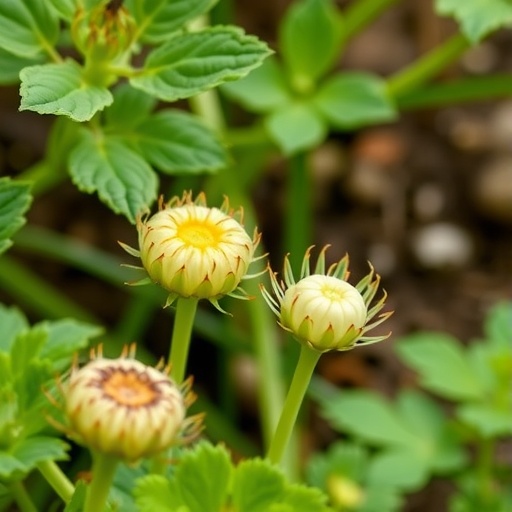In the ever-evolving field of microbiology, the pursuit of enhanced biocontrol strategies against plant pathogens has taken a significant leap forward. Recent research delves into the synergistic effects of microbial consortia, specifically focusing on the interaction between the genera Pseudomonas and Bacillus. This exploration is driven by the urgent need for sustainable agricultural practices that minimize chemical inputs while maximizing crop health and yield.
The intricacies of microbial interactions present a goldmine for scientists looking to harness these natural processes for biocontrol. The study conducted by Negrelli and colleagues identifies specific strains of Pseudomonas and Bacillus that demonstrate a remarkable ability to combat common phytopathogens, thereby reducing the reliance on traditional pesticides. These findings suggest that the careful selection of microbial strains can lead to more effective and environmentally friendly alternatives for managing plant diseases.
Biocontrol agents have been previously recognized for their role in disease suppression, yet the novel approach of co-cultivation between different microbial species has revolutionized the potential applications in phytopathogen management. The coupling of Pseudomonas and Bacillus strains may lead to enhanced production of bioactive compounds that are capable of inhibiting the growth of pathogenic fungi and bacteria, which is pivotal in crop protection strategies.
The researchers meticulously conducted experiments to determine how various strains of Pseudomonas and Bacillus could be paired effectively. By assessing their individual and combined effects on specific pathogens, it became evident that certain combinations outperformed others, highlighting the importance of strain selection in developing robust biocontrol solutions. This notion challenges traditional methods where single-strain applications have dominated the landscape of biocontrol research.
Furthermore, the role of metabolic extracts in mediating the interactions between these microbial strains cannot be overstated. The investigation uncovered rich profiles of metabolites that not only contribute to antimicrobial activities but are also indicative of the health and viability of the microbial consortia under varying environmental conditions. This metabolic activity presents an exciting frontier for future research, as understanding these biochemical pathways could lead to more targeted and efficient applications in agriculture.
Field trials and greenhouse studies further contextualized the laboratory findings, providing a glimpse into the practical implications of these microbial interactions in real-world scenarios. The significant reduction in disease incidence observed in crops treated with the Pseudomonas and Bacillus combinations suggests a promising avenue for future agricultural practices. Farmers may soon have access to reliable and sustainable strategies for managing plant health, particularly in the face of climate change and increasing pest resistance.
The implications of this research extend beyond agriculture alone. As global food security continues to be a pressing issue, the innovation of biocontrol methods utilizing microbial consortia may help ensure more resilient food systems. The shifts towards organic farming and integrated pest management practices remind us of the vital need for sustainable approaches that not only preserve crops but also protect ecosystems.
Another noteworthy aspect of this research is its focus on the metabolic interactions that occur during co-cultivation. Understanding how different strains communicate and cooperate within a microbial community can lead to the discovery of new biocontrol agents. This opens the door for extensive studies aimed at isolating and characterizing unique metabolites which might have profound implications in plant disease management.
Moreover, further exploration is warranted into how environmental factors influence these microbial interactions. The performance of Pseudomonas and Bacillus strains can vary dramatically depending on soil type, moisture levels, and temperature. Each of these variables must be rigorously examined to capitalize on the full potential of microbial consortia in diverse agricultural settings.
Ultimately, the research conducted by Negrelli et al. serves as a pivotal reminder of the relevance of microbial life in promoting ecological balance and agricultural productivity. As our understanding of complex microbial ecosystems improves, so too does our capacity to innovate biotechnological applications that optimize crop health and resilience. The findings, therefore, not only contribute to scientific knowledge but also serve as a clarion call for sustainable agricultural practices.
In conclusion, the groundbreaking work involving the co-cultivation of Pseudomonas and Bacillus strains provides a compelling blueprint for the future of biocontrol in agriculture. By understanding and harnessing the power of microbial interactions, we can pave the way for practices that protect both our crops and our environment. As we move toward a more sustainable agricultural future, the integration of microbial consortia into mainstream farming techniques promises to be a game changer.
These developments underscore the evolving relationship between human agricultural practices and the natural world, emphasizing a need for ongoing research and collaboration within the scientific community. The continuous study of microbial consortia will undoubtedly yield significant advancements, ensuring that the upcoming generations have access to safe, abundant, and nutritious food.
In the face of global challenges, it’s essential to recognize the potential within nature itself. The exploration of microbial cooperation encapsulated in this study not only demonstrates the ingenuity of scientific inquiry but also affirms the optimism that underlies the quest for innovative solutions in agricultural science.
As researchers carry forward this momentum, we can expect to see increased interest and investment in the field of microbial biotechnology, with far-reaching implications for sustainable agriculture, food security, and environmental health. The future looks promising for the next chapter in biocontrol research, as we stand on the brink of uncovering the full potential of microbial life in supporting our agricultural needs.
Subject of Research: Microbial consortia involving Pseudomonas and Bacillus strains for biocontrol activity against phytopathogens.
Article Title: Microbial consortium involving Pseudomonas and Bacillus: strain selection and the effect of co-cultivation on biocontrol activity against phytopathogens and the composition of metabolic extracts.
Article References:
Negrelli, J.G.D., de Britto Rafael, M.R., Gazola, V.D. et al. Microbial consortium involving Pseudomonas and Bacillus: strain selection and the effect of co-cultivation on biocontrol activity against phytopathogens and the composition of metabolic extracts. Int Microbiol (2025). https://doi.org/10.1007/s10123-025-00668-1
Image Credits: AI Generated
DOI: https://doi.org/10.1007/s10123-025-00668-1
Keywords: Microbial consortia, biocontrol, Pseudomonas, Bacillus, phytopathogens, sustainable agriculture, metabolic extracts, strain selection.




